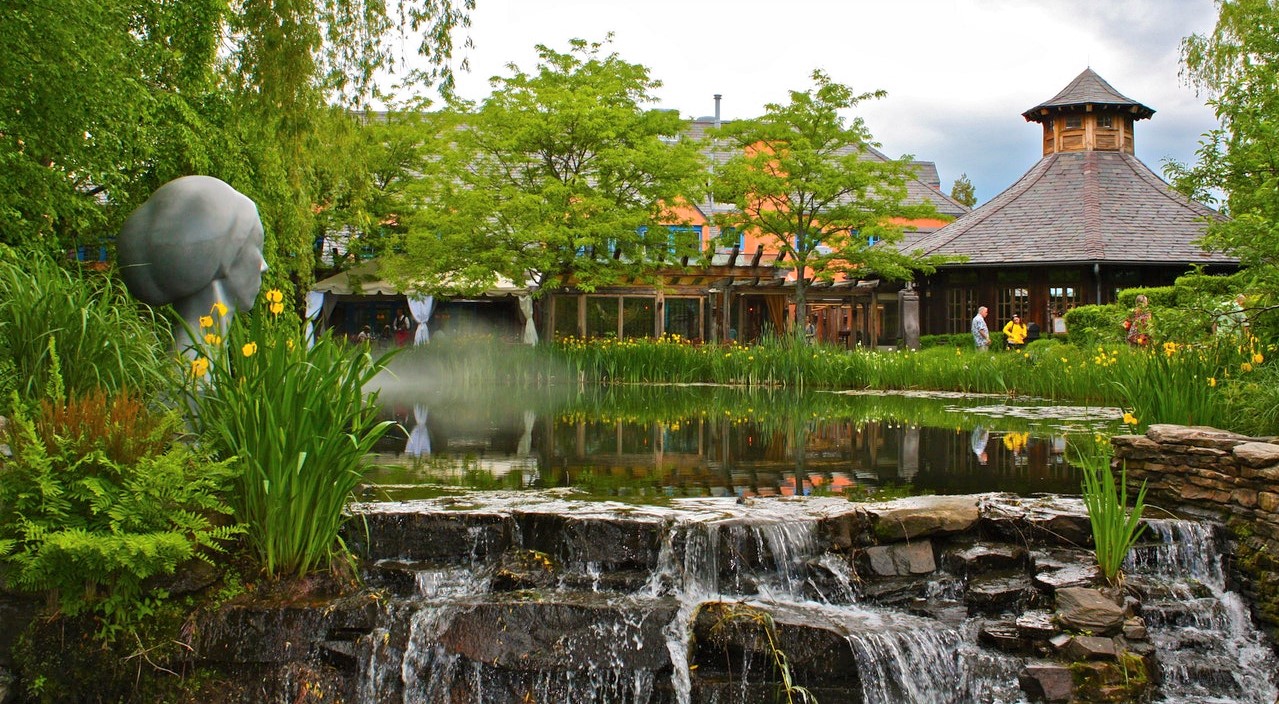Zen Minimalism

Zen Minimalism transcends aesthetics and products; it is an all encompassing life philosophy that elevates simplicity to an art form. An intensely personal search for meaning that strips away excess layers to focus on the absolute essentials, this design style embodies natural, organic living. A complex, ordered use of empty space brings alive the beauty of simplicity, a style synonymous with renowned Japanese architect Tadao Ando. Unobstructed space, abundant light, minimalist lines and natural materials characterize the Zen Minimalist home, creating an overall feel that is peaceful and meditative.

Balance and harmony in nature
Zen Minimalism: Pure, Serene, Simple
Tranquil, uncluttered spaces in earthy, natural colours. Clean, pure lines that create an oasis of calm. The gentle sound of flowing water; a play of soft natural light. The Zen Minimalist home embraces balance, harmony and simplicity with a decidedly meditative feel. Drawing inspiration from 'Zen', a twelfth century Japanese school of Mahayana Buddhism, this is a home consciously designed for living and experiencing mindfully and authentically.

Fallingwater
Zen Minimalism celebrates nature and open spaces; an influence that can be seen in the works of architectural legend, Frank Lloyd Wright. Fallingwater in Pennsylvania, one of his seminal works, emphasizes the Zen principles of harmony and balance between man and nature. Built on top of an active waterfall, the house integrates the natural surroundings within the living spaces, from rock ledges in the living room; a natural spring dripping water inside the house; to sweeping expanses of windows and balconies reaching out to the surroundings.

Zen courtyard
The Calvin Klein flagship store at Madison Avenue, NYC might seem like an unlikely place to find the principles of Zen Minimalism at play. However, British architect John Pawson who conceptualised it has ensured that along with high fashion, the store pays homage to the clean, minimal aesthetic that defines the Zen Minimalist style. Much of his work is defined by its focus on order, purity, simplicity and drawing out the innate quality of every decor element, from the suffusion of natural light to highlight a space to the use of earthy textures. Known for his minimalist driven perfectionism, Pawson's penchant for clean, stripped down interiors is legendary. It also seems to be what a great boyhood can be made up of; his two sons had a great time growing up around Pawson since empty houses make for great skateboarding! His wife Catherine Pawson, an interior designer herself, has been known to joke about how she had to wait twenty years before she could convince her husband to get a sofa for the family home. His standard response to a request for one would typically be, "I don't see why you need one anyway. If you need to lie down, then go to bed"! Staying true to the Buddhist philosophy of not being bound to material possessions, the Zen Minimalist home favours a sparse and fresh design approach over an ornate or embellished one.

Shoji screen
Creating a Zen home, your way
Embrace the Zen Minimalist style in your home by paring down to the essentials. You needn't toss out that sofa just yet, but doing away with the clutter and any superfluous excesses will make way for a space that maintains an open, unobstructed flow. Shoji screens are a quintessentially Japanese design element that allow for a seamless integration between the outdoors and indoors, while suffusing the home with an abundance of natural light. These delicate, rice paper covered latticework frames slide open and shut, efficiently harnessing space, and can be used for a variety of purposes from concealing storage units to acting as room dividers.

Shoji Hamada stone bowl
The colour palette is earthy and neutral with subtle, subdued notes. Creamy whites merge with espresso browns to create a calm, comforting feel. A monochromatic colour palette lends itself beautifully to creating an aura of serenity, but that doesn't mean you can't inject a few bold colour accents. The key is to restrict yourself to one or two hues in a few focal points so as not to upset the balance that is such a fundamental part of this style. Bring in a vibrant yellow with a single Shigeru Uchida minimalist chair in your living room. Or place a few classic Shoji Hamada stone bowls in broken sugarcane patterned turquoise blue on the dining table. At Hamada's compound in Mashiko, Japan, the long table would be filled with handsome plates and bowls displaying his trademark sugarcane motif at mealtimes. The constant repetition of this motif was sometimes considered bewildering for such a creative individual, but for Hamada each rendition was new and vigorous, making it a pattern which was the same, and yet not the same, creating a perpetuity beyond time and place.

Minimalistic living area
Zen Minimalism embraces natural, organic materials and textures in earth, stone and wood. Mellow brick walls and strong timber doors bring in a sense of rootedness; wooden flooring lends a dulcet warmth. Carpets in bunting wool or pure cotton place softness underfoot.

Tatami mats
Sleek and minimalist tatami mats, a quintessential symbol of Japanese elegance, offer a beautiful, traditional style of floor covering. Created from woven rush grass around a rice straw core, tatami mats were traditionally arranged in specific sizes and patterns according to the dimensions of the room. Historically associated with Japanese nobility, these mats are treated with an almost sacred reverence in traditional Japanese homes. Walking on the tatami with shoes on is absolutely forbidden, for one. In the 1964 Tokyo Olympics, Anton Geesink, a two time world Judo champion of Dutch origin, defeated the famed Akio Kaminaga on home turf, causing a frenzy of paparazzi to run onto the tatami clad arena with their shoes on. They were immediately stopped by Mr. Geesink and sternly reprimanded, representing a deep understanding of the traditional Japanese respect for tatami.

Large windows overlooking the garden
With nature playing such a pivotal role in the Zen Minimalist home, large windows that bring in the outdoors through expansive views can be a great advantage. There are but a few things that can compete with the unmarred beauty of fabulous natural vistas. Don't fret if your view is nothing to write home about though; you can create the Zen feel with a few simple, natural elements. Traditional plants like bonsai and bamboo infuse vitality, the deep green fronds creating an aura of peaceful contemplation. The sound of softly flowing water features such as indoor fountains or a water wall, heighten the sense of reflective calm. A traditional rock garden in an inner courtyard is a brilliant way to harmonize with nature; but the beauty of smooth, polished rocks can extend to wall coverings and textured floorings just as well. Or create your own little sliver of tranquility in your private bathing area. Pick from a minimalistic sunken soaking tub, an uplifted river rock bathtub or a walk in rain shower; envelop the space in vanilla hued shades; bring in a single spray of deep purple orchids and wash your worries away.

Garden Buddha statue
A home that complements your life
"Better than a thousand hollow words, is one word that brings peace." - Gautama Buddha. The Zen Minimalist in you couldn't agree more! This is the philosophy you live by, be it your relationships or your choice of decor. The design of your home may look effortless in its beautiful simplicity, but you know the painstaking detail with which every element has been chosen, paring items down to the absolute essentials and seeking to bring out the intrinsic nature of each.

Scene from 'Lost in translation'
It is this essence that you seek in your diligent practice of yoga, in the sun-kissed, tatami clad little meditation corner you have created for yourself in your home. This is the space you often retreat to for quiet contemplation; a zone free from the disruptive influence of the electronic devices you like to detach from every once in a while. And when you do allow technology into your private space, it may only be to lose yourself into the contemplative rhythms of Njosnavelin or Six Pianos; or to watch Lost in Translation for the umpteenth time. So well known is your love for this particular Sofia Coppola film, your inner circle of intimates has gifted you a handmade poster of the movie which now occupies a quiet corner of your study. It is one among the few concessions you've made for art on the largely empty walls, barring a few striking works by Reinhardt you've treasured over the years.

Indonesian beach
A getaway for you often means an immersion into the solitude of a yoga and meditation retreat, tucked away in the stillness of a hut in the Surrey Hills over a weekend, or on a tranquil beach in Ubud for a longer sojourn. Under the swaying coconut palms of an almost-hidden garden by the beach, dressed in your trademark organic bamboo leggings and flowing hemp tunic you ponder over the intricacies of inner bliss.

Aveda products
You are at your happiest immersed in the sights and sounds of the elements that surround you and constantly strive for a greater balance with nature in your everyday life. No wonder then, that even your Aveda shampoo smells of camomile and cherry blossoms! Much like the founder of Aveda, Horst Rechelbacher who famously turned to herbal remedies and yoga to heal himself from stress and burnout, you cocoon yourself in the giving embrace of holistic, organic living. Little pots of peppermint grow in your kitchen, their minty fragrance mingling with the crusty rosemary foccacia you love to bake.

Beautiful zen garden
Your home is the sanctuary you turn to for serenity, a space within which the carefully blended balance of energy creates a lasting feeling of harmony. A home that doesn't just calm the mind and body, but gives the soul room to breathe.